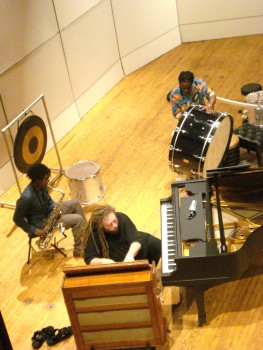The Sound of Sci(l)ence

Among The Sound of Sci(l)ence performances was a jazz improvisation by Will Calhoun on drums, Jaron Lanier on piano and celesta, and Haverford physics professor Stephon Alexander on saxophone.
Details
What happens when three visionary musicians/composers/filmmakers/visual artists/polymaths meet up with a posse of Haverford science professors and their students?
All sorts of interesting things, as those who attended“The Sound of Sci(l)ence” event on Haverford's campus found out. The three-day series of workshops, conversations and performances, which ran June 15-17, featured Will Calhoun, a Grammy Award-winning percussionist and member of the band Living Colour; Jaron Lanier, an artist, composer, writer and virtual reality pioneer; and Paul Miller (aka DJ Spooky), a hip-hop musician and performance artist.
“The Sound of Sci(l)ence” (subtitled“Listening to Quantum Mechanics, the Big Bang and Nanotechnology”) was funded by a Mellon Arts Residency Planning Grant from Haverford's Hurford Humanities Center as part of its mission to stimulate new ways of looking at the arts and how they can connect to and illuminate Haverford's curriculum. Organized by professors Joshua Schrier (chemistry) and Stephon Alexander (physics), the idea behind the gathering was to explore the intersection of music and quantum mechanics, which both deal with wave phenomena. The aim: to discover whether music could offer some useful analogies for teaching some of the complex concepts of quantum mechanics, a branch of physics that studies the behavior of matter and energy on the scale of atoms and subatomic particles.
The line-up of events in the series included an open panel discussion on the connections between concepts of quantum mechanics and sound, as well as a virtuoso performance by Will Calhoun on the Wavedrum, a programmable electronic percussion instrument with a pressure sensitive acoustic surface that can reproduce a universe of musical sounds. Paul Miller/DJ Spooky screened his newest work, Rebirth of a Nation, which applies a“DJ mix” to D.W. Griffith's notorious 1915 silent film Birth of a Nation, along with an original score performed by the Kronos Quartet. (After the Haverford event, Miller's film went on to a screening at New York's Museum of Modern Art.) Closing out the series was a performance by Calhoun on percussion, Jaron Lanier on piano and Stephon Alexander, an accomplished musician as well as a physics professor, on saxophone.
That final performance had an unusual twist though, says Alexander, who has played with Lanier and Calhoun before.“We opened it up with Josh Schrier giving the background on a fundamental problem in quantum mechanics called ‘the measurement problem,' ” says Alexander.“Josh gave this very clear and accessible presentation and then we used that to show how you could think about the measurement problem with a jazz group improvisation.”
Events that bring together science and the arts are becoming a hot trend, says Alexander, who has participated in the World Science Festival in New York (now in its second year) and will give a presentation at the Genoa Science Festival in Italy in the fall.“But what came out of the ‘Sounds of Sci(l)ence' event at Haverford was something unique,” he says.“It revealed the potential for a genuine interface where scientists and artists can take in new concepts. And that can make our science and our art better.”
“We got some very good ideas out of this—some far better analogies than we had thought of before,” says Schrier, who says plans are in the works to try to bring the three artists back to campus for longer residencies.“There are a lot of different ways they could interact with faculty and students,” says Schrier, who points out that Will Calhoun has done extensive ethnographic research on drumming and rhythm patterns around the globe.“Part of having this grant was getting the chance to interact with our colleagues in the social sciences and humanities and these visitors could plug into their curricula as well.”
--Eils Lotozo



